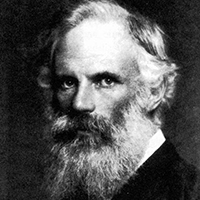George Francis FitzGerald
Prof George Francis FitzGerald FRS FRSE was an Irish academic and physicist who served as Erasmus Smith’s Professor of Natural and Experimental Philosophy at Trinity College Dublin from 1881 to 1901.
George Francis FitzGerald, a physicist who first suggested a method of producing radio waves, thus helping to lay the basis of wireless telegraphy. He also developed a theory, now known as the Lorentz–-FitzGerald contraction, which Einstein used in his own special theory of relativity.
George Francis Fitzgerald was born at Monkstown, Co. Dublin. His father William, a Trinity professor. His mother Anne was sister of George Johnstone Stoney the distinguished Irish physicist who, among many notable contributions, named the electron. George’s early education, together with his brothers and sisters, was undertaken at home, where they were tutored by M.A. Boole, a sister of George Boole, Professor of Mathematics at University College Cork and widely acknowledged as ‘The Father of Computer Science’. Fitzgerald showed himself to be very able at mathematics and dextrous at mechanical construction.
George entered Trinity College Dublin (TCD) at the age of 16 to study mathematics and experimental science and he graduated in 1871 at the top of his class.
Fitzgerald studied for 6 more years before attaining his goal of winning a Trinity College Fellowship in 1877. During this time he laid down the foundation of his research career. Probably the most significant work he studied was the Treatise on Electricity and Magnetism published by James Clerk Maxwell in 1873.
FitzGerald became a tutor at Trinity College in Dublin in 1877 and professor of natural and experimental philosophy in 1881. From his studies of radiation he concluded that an oscillating electric current would produce electromagnetic waves. This finding was later verified experimentally by Heinrich R. Hertz of Germany and used in the development of wireless telegraphy. Fitzgerald was the first to suggest a method of producing radio frequency waves that are so widely used today for radio and TV, navigational aids, mobile phones, satellite communication and radio astronomy. Independently of Hendrik A. Lorentz of the Netherlands, FitzGerald studied the results of the Michelson-Morley experiment (1887) and arrived at a similar conclusion. The experiment was an attempt to measure the Earth’s motion relative to the pervasive luminiferous ether postulated as the medium within which light waves were propagated. The attempt failed to detect any such motion. In 1892 FitzGerald suggested that a body when in motion is shorter (along its line of motion) than when at rest and that such a shortening, or contraction, affects the instruments used in the experiment. Lorentz arrived at this idea independently in 1895 and developed it considerably. A collection of his work, The Scientific Writings of the Late George Francis FitzGerald, was published in 1902.

George Francis FitzGerald
Date of Birth: 03 Aug 1851
Birth Place: Dublin, Ireland
Proffession: Physicist
Nationality: Ireland
Death: 22 February 1901, Dublin, Ireland


